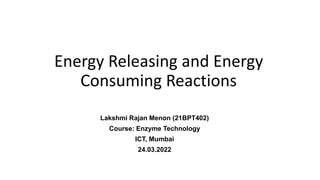
Energy Consuming & Energy Releasing Reactions.pptx
- 1. Energy Releasing and Energy Consuming Reactions Lakshmi Rajan Menon (21BPT402) Course: Enzyme Technology ICT, Mumbai 24.03.2022
- 2. Energy in reactions • Biochemical reactions involve changes in the chemical bonds that join atoms in compounds • Some reactions release energy & often occur on their own, or spontaneously. • Chemical reactions that absorb energy will not occur without a source of energy. • Energy changes are one of the most important factors in determining whether a chemical reaction will occur. 2
- 3. Exothermic and Endothermic Reactions 3
- 4. Thermodynamics ΔG=ΔH−TΔS • ∆H is the enthalpy change. Enthalpy in biology refers to energy stored in bonds, and the change in enthalpy is the difference in bond energies between the products and the reactants • ∆S is the entropy change of the system during the reaction. If ∆S is positive, the system becomes more disordered during the reaction • Temperature (T) determines the relative impacts of the ∆S and ∆H terms on the overall free energy change of the reaction 4
- 5. ΔG : Gibbs free energy change • ΔG=ΔH−TΔS • Reactions with a negative ∆G release energy, which means that they can proceed without an energy input (are spontaneous). In contrast, reactions with a positive ∆G need an input of energy in order to take place (are non- spontaneous) 5
- 6. Exergonic and Endergonic Reactions • Reactions that have a negative ∆G, release free energy and are called exergonic reactions ΔG = G final – G initial • A negative ∆G means that the reactants, or initial state, have more free energy than the products, or final state. • Reactions with a positive ∆G, require an input of energy and are called endergonic reactions. • In this case, the products, or final state, have more free energy than the reactants, or initial state. Endergonic reactions are non-spontaneous, meaning that energy must be added before they can proceed 6
- 7. Endergonic and Exergonic Reactions : An Example • If a reaction is endergonic in one direction (e.g., converting products to reactants), then it must be exergonic in the other, and vice versa. • In biochemical systems, endergonic & exergonic reactions often are coupled, so the energy from one reaction can power another reaction. 7
- 9. Other examples : • Examples of exergonic reactions include exothermic reactions, such as mixing sodium and chlorine to make table salt, combustion, and chemiluminescence (light is the energy that is released). • Examples of endergonic reactions include endothermic reactions, such as photosynthesis and the melting of ice into liquid water. • Please note: A spontaneous (exergonic), endothermic reaction can occur when the changes in enthalpy and entropy yield a negative Gibbs free energy (ΔG will be negative only if TΔS is bigger than ΔH. Hence these reactions are spontaneous only if the entropy increase is sufficient to overpower the unfavorable enthalpy change) 9
- 10. 10
- 11. Role of enzyme • Chemical reactions of metabolic pathways do not take place on their own. Each reaction step is facilitated, or catalyzed, by an enzyme. • Enzymes are important for catalyzing all types of biological reactions—those that require energy as well as those that release energy. • In order for the reaction to take place, some or all of the chemical bonds in the reactants must be broken so that new bonds, those of the products, can form. • To get the bonds into a state that allows them to break, the molecule must be contorted (deformed, or bent) into an unstable state called the transition state. • The transition state is a high-energy state, and some amount of energy must be added in order for the molecule reach it. 11
- 12. 12
- 13. Enzymes and Activation Energy • The energy that is needed to get a reaction started is called the activation energy. • Enzyme speeds up the rate of a chemical reaction. • They work by lowering a reaction’s activation energy. 13
- 14. 14
- 15. Endergonic and Exergonic Reactions Enzymes : An Example ATP Synthase ATP Hydrolase 15
- 16. It is important to remember that enzymes do not change whether a reaction is exergonic (spontaneous) or endergonic. This is because they do not change the free energy of the reactants or products. They only reduce the activation energy required for the reaction to go forward Please note! 16
- 17. Summary • Energy releasing reaction spontaneous Exergonic reactions • Energy absorbing reaction non-spontaneous Endergonic reactions • Spontaneous ≠ rate of reaction • Enzyme speeds up the rate of a chemical reaction by lowering a reaction’s activation energy • They catalyze both spontaneous and non-spontaneous reactions • They cannot change exergonic to endergonic and vice versa 17
- 18. References • https://www.masterorganicchemistry.com/2011/09/28/hammonds-postulate/ • https://opentextbc.ca/biology/chapter/4-1-energy-and-metabolism/ • https://rwu.pressbooks.pub/bio103/chapter/introduction-to-metabolism-enzymes-and-energy/ • https://www.khanacademy.org/science/biology/energy-and-enzymes/introduction-to-enzymes/a/activation- energy • https://openstax.org/books/microbiology/pages/8-1-energy-matter-and-enzymes • https://www.ncbi.nlm.nih.gov/books/NBK9921/ • https://www.khanacademy.org/science/biology/energy-and-enzymes/free-energy-tutorial/a/gibbs-free- energy 18